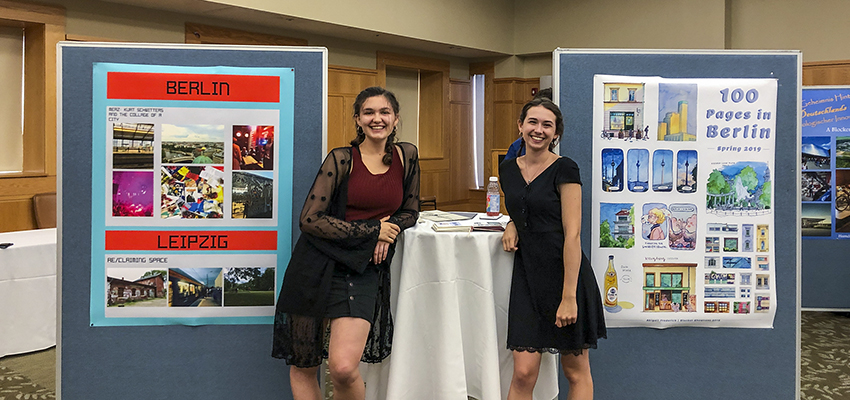
HWS News
13 November 2019 Germany Explored with Blocker Funding

Students present their posters at the Blocker Showcase.
Thirteen recipients of the Julius G. Blocker ’53 Endowed Fund, which enables students to pursue their academic curiosities in cities throughout Germany, brought their insights on architecture and memory, street art culture and Swabian Castles, among other topics, back to campus with global insight and perspective.
While abroad, these students recorded their experiences by blogging and presented posters at the annual Blocker Showcase in the Vandervort Room in October. Through the Blocker grant, students choose between five locations and seven programs.
Four students studying through the Lexia International Program for Art and Architecture exploring the architecture in Berlin.
Michael DiBenedetto ’20 explored how the city of Berlin has used memorialization to heal from World War II and the impact the Nazis had on the city and its architecture. He titled his project, “Architecture of Memory: An Investigation of Berlin’s Memorial Culture.”
Lauren Downes ’20 titled her project, “Kunstserie,” which translates to “Art Series.” In her collection, Downes explores public serial art in Berlin, which she defines as art that is accessible to all and has multiple pieces that work in a series.
Bramm Watkins ’20 project, “Architectural Vignettes of a Changing City,” explores the historic traces in many of Berlin’s architectural elements.
Emily Watson ’20 compared modern art in Berlin to cities in France where she took excursions through her blog, “Leidenschaft Für Die Moderne.”
Another semester long program in Berlin, IES Abroad, allowed two students to enroll in the “Metropolitan Studies Track.”
Abbey Frederick ’20 documented “100 Days in Berlin,” by painting a watercolor of her surroundings every day. Her blog was inspired by the course “Watercolor” taught by Associate Professor of American Studies Kirin Makker.
Before leaving for study abroad, Ruby Williams ’20 studied the artist Kurt Schwitters. Schwitters created the concept of “Merz,” a collage that helps an artist document the world around them. For her project, Williams created her own “merz” chronicling Berlin’s society and visual culture.

Hamden Ahmed ’20 details the many ways that Bremen as a city is always advancing technologically, as well as how the country of Germany has embraced technological innovation.
On the other side of Germany, Hamden Ahmed ’20 studied abroad at the University of Bremen. His project, titled “Das Geheimnis Hinter Deutschlands Technologischer Innovation,” details the many ways that Bremen as a city is always advancing technologically, as well as how the country of Germany has embraced technological innovation.
In the South of Germany, Chad Kilvert ’20 studied for a semester in Freiburg through an IES Abroad program on the Environmental Studies and Sustainability Track. His project “Nachhaltigkeit In Deutschland” furthered his studies in sustainability.
Nearby, Elizabeth Fajardo ’20 spent a year as an exchange student at the University of Tübingen. For her project, Fajardo looked at castles in Swabia, a region in Baden-Wurttemberg in the southwest of Germany. Fajardo recounts that this experience, “allowed her to view a more long-term perspective on human history.”
Four students completed a month-long language immersion program in Leipzig, Germany, including: Caleb Austen ’22, Alyssa Hamilton ’19, Morgan Neils ’21 and Katie Percoski ’21.
